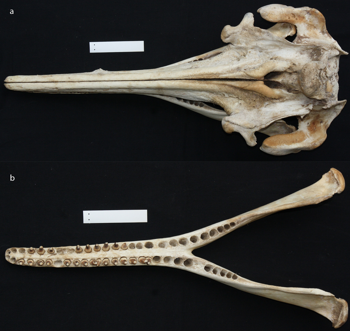Dolphin Discovery

You may be surprised to learn that river dolphins are not very closely related to their marine counterparts, or even to each other. River dolphins are found in the Amazon, Orinoco, Indus, Ganges, and (until very recently) Yangtze rivers. These dolphins all share the same adaptations for life in these muddy, slow flowing river systems. These include a long, narrow mouth used to catch fish with broad sweeping bites, well developed sonar for piercing the silt and detritus, and a more flexible spine for slipping between branches and rocks. Despite these similarities, the river dolphins derive from four unique families. Iniidae live in South American rivers, Pontoporiidae in estuaries in Argentina, Lipotidae in China (though they are now extinct), and Platanistidae in India. Of these, only the Iniidae and Pontoporiidae are closely related, and no family is closely related to the oceanic dolphins. Paleontologists have speculated on this, and the most widely accepted theory is that the ancestors of modern river dolphins were coastal dolphins who were outcompeted in their native environment by modern oceanic dolphins. Although this seems true enough, paleontologists lacked the specifics of time and place that would help them get a clearer view of the transition, because coastal fossils are rarely easy to find or extract. However, they no longer lack for evidence thanks to the discovery of one of these ancient ancestors.
This newly uncovered creature is known to science as Isthminia panamensis. As it’s name suggests, it was found off the shore of Panama. It has been tentatively categorized as a common ancestor of Iniidae and Pontoporiidae dolphins, and as one might expect, it shows many traits in common with its descendants, such as its long, thin snout and broad flippers. However, it also has traits that show clear adaptation for marine life, such as larger eyes than those of its descendants and teeth that more closely resemble those of oceanic dolphins. It lived about 6 million years ago, during a time period known as the Late Miocene. In the eyes of paleontologists such as Isthminia’s discoverer, Nick Pyenson, this creates an interesting situation, because there were two waves of river dolphin colonization in South America. The first included river dolphins of the family Platanistidae, who appeared from 16 to 11 million years ago but disappeared from the fossil record afterward. The second contained the families that today live in South America, and began in the Late Miocene. So this species is most likely to be the ancestor of the second wave, the Iniidae and Pontoporiidae, but it could also be the descendants of the Platanistidae, or even another group relatively distant to either. No matter how this creature is classified, it gives paleontologists and intriguing look into the complicated process of river dolphin evolution.
Additional information about Isthminia panamensis:
http://phenomena.nationalgeographic.com/2015/09/09/fossil-river-dolphin-lived-out-at-sea/
Additional information about modern river dolphins:
http://www.dolphins-world.com/river-dolphins/
Super complicated stuff for those who’d like to see what scientists think about the topic:
Whitney • Sep 16, 2015 at 12:26 pm
Fascinating and tastefully written, thanks for sharing your Daly Dino Facts with us Pete!